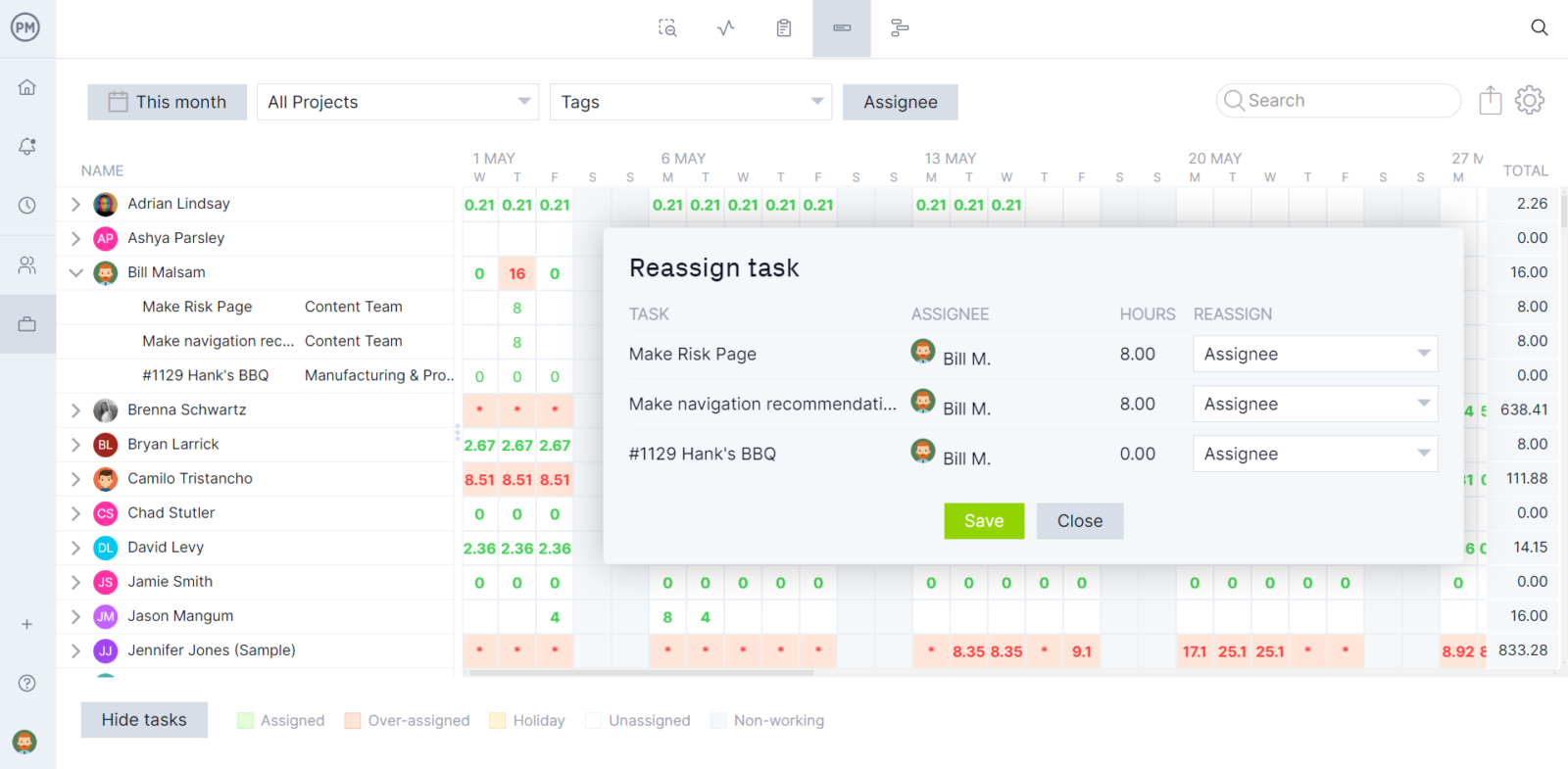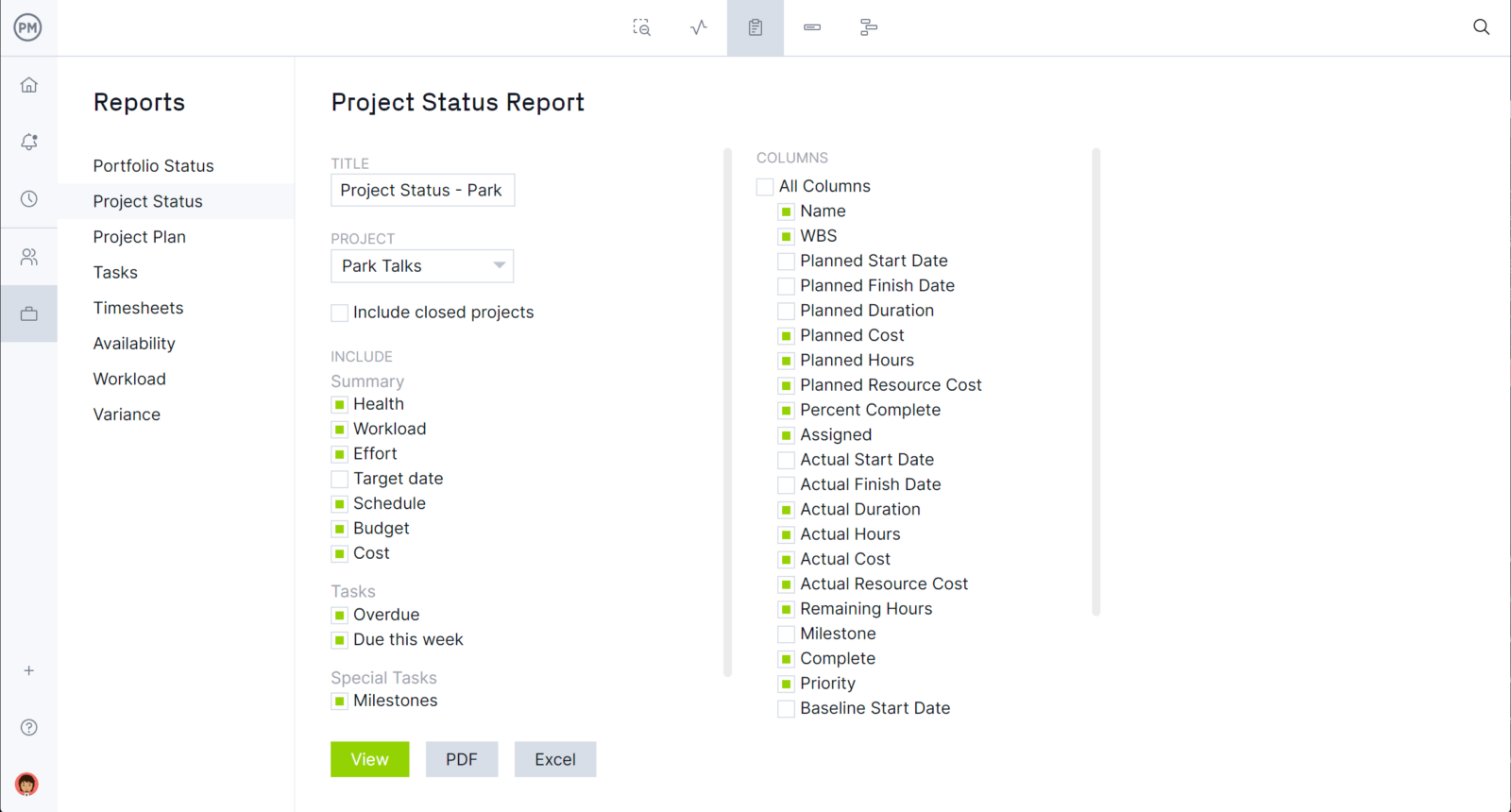Manufacturing is based on delivering quality and quantity products to the market on schedule. Using manufacturing KPIs can help you determine strengths and weaknesses that can direct you toward improvements in all phases of your production cycle.
Manufacturing KPIs are key performance indicators and we’ll go into greater detail about the definition and why manufacturing metrics are so important. Then we’ll list the 10 most important manufacturing KPIs and conclude with how project management software can help you track them.
What Are Manufacturing KPIs?
Manufacturing KPIs are like any KPI in that they’re a metric to quantifiably measure performance over time; in this case, the KPIs focus on manufacturing. In terms of manufacturers, these KPIs are used to monitor, analyze and optimize operations. Teams can use the data to compare to their previous output and see how they compare to their competitors while pinpointing inefficiencies.
This is useful information to improve production by capturing what’s working and where there’s room to improve. That can mean reducing waste or even automating processes to keep production teams focused on more important tasks while the smaller tasks are taken off their plate. KPIs provide insights into challenges and successes in manufacturing operations that can be resolved or exploited.
When defining metrics for KPIs, it’s best to follow the SMART method. This technique stands for specific, measurable, actionable, realistic and time-based. For example, you don’t want to set a goal that’s unrealistic and cannot be achieved regardless of how much hard work is put in. Also, whatever goals are decided upon, it helps to have actionable steps to get there.
Whatever manufacturing KPIs you choose, you need to see them in real time rather than seeing a record of what’s already occurred. If you’re looking at old data, then you’re not sure what’s happening on the production line and your response will lag compared to the actual progress and performance of your production team. That’s why collecting manufacturing metrics with project management software is recommended.
ProjectManager is online project management software that uses real-time data to show your manufacturing schedule as it evolves. You can get a high-level view of your production process with our Gantt charts that manage and visualize KPIs. They display planned vs. actual production output over time to reveal and deviations from the target. Use the Gantt chart to monitor and analyze cycle times and track progress in real time.

Why Are Manufacturing KPIs Important?
Manufacturers who want to stay competitive and succeed in business will benefit by using manufacturing KPIs. Otherwise, you’re just going by your gut when it comes to managing your manufacturing operations. As good as your instincts might be, without quantifiable data to back them up, you’re only guessing and can’t motivate production teams, executives, investors and so forth.
Look for an industry leader in manufacturing and you’ll find a company that uses manufacturing KPIs to increase their speed to market without adding excess expenses to their process. The manufacturing metrics point the way forward, which could lead to automation, reducing waste or having only the inventory on hand that you need rather than wasting money on unnecessary warehouse space.
There are as many reasons why manufacturers should use KPIs as there are KPIs. For example, you can uncover opportunities in your manufacturing cycle that were previously unaware of. These opportunities can lead to greater customer satisfaction, which not only improves your competitiveness but strengthens brand loyalty. You might even find ways to reduce costs, which customers will also like. Manufacturing KPIs need to be reviewed regularly and adjusted to keep you on track.

Get your free
Production Schedule Template
Use this free Production Schedule Template for Excel to manage your projects better.
20 Manufacturing KPI Examples
By now, you should be sold on the effectiveness of manufacturing KPIs. But so far, we’ve only talked about the subject without getting into specifics. There are many different KPIs and each company has to determine what’s right for them by seeing how they align with the company’s production management goals. As noted earlier, manufacturing metrics also must be specific and measurable and provide an achievable value.
Here are 20 of the most common production and manufacturing KPI examples.
1. Cost Per Unit (CPU)
The cost per unit is how much money you’re spending for each item produced. This is an extremely important manufacturing KPI for you to determine a profitable price point for your product. Therefore, consider all associated costs, such as materials, overhead, depreciation, labor and so forth, and then divide that by the number of units manufactured.
While not specifically related to manufacturing or production, this is a valuable KPI in that getting product to customers when they expect it is a make-or-break for your company. To calculate this KPI, you need to multiply the units delivered on time by 100 and then divide that figure by the number of units you have delivered. This creates a percentage of products that you’ve delivered on time to your customers.
2. Production Volume
Production volume measures the output for a period. This production KPI allows manufacturers to benchmark their manufacturing efficiency and understand the total units that are manufactured by the factory and determine whether they’ll meet their production budget. It’s determined by the total number of products manufactured over a specific period.
3. Production Downtime
Production downtime is the amount of time a factory’s production lines aren’t operating. This covers both planned downtime and unplanned downtime. Naturally, the less downtime you have, the more productive your manufacturing. To figure out production downtime add all the downtime over a specific timeframe.
4. Overall Operations Effectiveness (OOE)
Overall operations effectiveness is performance (percentage of time your plant is working at full capacity) multiplied by quality (the quality units produced in terms of a percentage of all units started) by availability (actual production time as a percentage of scheduled time to operate). Machine maintenance isn’t included in availability.
5. Overall Equipment Effectiveness (OEE)
Overall equipment effectiveness measures how productive your manufacturing plant is with no downtime by percentage. It can be calculated by multiplying performance by quality by availability. This helps you know how long equipment on your production line can operate at its peak. In this calculation, you do include machine maintenance downtime.
6. Total Effective Equipment Performance (TEEP)
Total effective equipment performance measure utilization. It shows how your production is doing compared to if it was running all the time, all year, while always producing quality products. Again, this is determined by performance multiplied by quality by availability.
7. Capacity Utilization
Your production capacity refers to the total production volume that can be manufactured with your current resources such as materials, labor or capital assets. The capacity utilization metric helps you determine the rate to which you’re using your production capacity. Ideally, you should use as much of your resources as possible to generate the most revenue per employee and use capital assets profitably.
Capacity Utilization = (Production Capacity Used Over a Specific Period / Total Production Capacity) * 100
8. First Pass Yield (FPY)
A first-pass yield is the number of non-defective products that don’t require any reworking in your first run at the plant. It can help you find issues in your manufacturing process. To calculate this manufacturing KPI, divide the number of non-defective products by the total number of products manufactured.
9. First Time Right (FTR)
This is a production metric that’s used as part of the total quality management (TQM) approach. The first time right (FTR) measures the ratio between the total units produced and the defective units. By measuring this, manufacturers can pinpoint potential problems in the production line and take corrective actions.
First time right (FTR) = (Total production units without defects / total number of manufactured units) * 100
10. Work-In-Process
An important production KPI, the work-in-process also known as WIP, allows you to measure the quantity and cost of the materials, parts or components from your production inventory as they’re transformed into finished goods through each of the steps of your manufacturing process.
(Beginning WIP Inventory + Manufacturing Costs) – Cost of Goods Manufactured = Ending WIP Inventory
11. Return on Assets (ROA)
This manufacturing KPI helps you determine the income generated by the capital assets that are utilized to manufacture your products. It will help you determine whether purchasing a particular piece of equipment or machinery has been profitable for your organization or not.
Return on assets (ROA) = Net Income / Average Value of Assets
12. Lead Time (LT)
Similar to cycle time, lead time measures the time that passes from the moment a customer places an order to its delivery date. This is a manufacturing metric that goes beyond the production process and also involves the manufacturer’s ability to execute other activities to fulfill customer orders such as managing its warehouse, shipping and delivering products on time.
Lead Time = Date when customer order is received – Date when customer receives order
13. Cycle Time
Cycle time is used to measure the time it takes to process raw materials, parts and components into a product from start to finish. This manufacturing KPI is very important when gauging the success of production optimization strategies such as rethinking your production routing or the shop floor plan.
Cycle Time = Net Production Time / Number of Units Produced
14. Cost of Goods Manufactured (COGM)
The cost of goods sold or COGM measures the costs that are directly related to the production of goods such as direct materials and labor and manufacturing overhead. Besides helping gauge the profitability of a production process, this is a very important metric because manufacturers need to include this value as an expense in their income statements.
COGM = (Beginning WIP inventory + Total Manufacturing Costs) – Ending WIP Inventory
15. Cost of Goods Sold (COGS)
As its name suggests, COGS is a similar metric to COGM but the cost of goods sold measures other costs which are required to sell the product, such as sales, marketing and administrative costs.
16. Takt Time
This metric helps you plan your production schedule based on the customer demand for your product. The more customer demand there is for your product, the faster it needs to be produced. This metric also allows you to estimate the production volume that needs to be manufactured.
TAKT Time= Net Time Available for Production / Estimated Customer Demand
17. Scrap Rate
This manufacturing KPI measures the volume of the discarded production materials compared to the total volume of materials used. It’s important to monitor this metric so you can minimize waste and make your production process more efficient and profitable.
18. Mean Time Between Failure (MTBF)
Production machinery and equipment will fail at some point, which is normal even if you have a rigorous maintenance schedule. This manufacturing KPI helps you gauge the failure rate of each of your production equipment pieces so you can determine which are the most reliable and which require closer supervision.
19. Maintenance Unit Cost
This metric can help you gauge how the cost of your maintenance activities impacts the profitability of your products by looking at the cost of making each unit. You can do this by allocating the maintenance costs of a piece of equipment to the units that it has produced over time. For example, you can calculate this for a period of a month, a quarter or a year. This will help you make decisions such as investing in machinery or re-thinking your maintenance schedule.
Maintenance Unit Cost = Total Maintenance Costs of a Piece of Equipment / Number of Products Produced
20. Changeover Time
Most manufacturers use the same machinery and equipment to make various products, but usually, some adjustments are needed before switching from one product to another. Changeover time is a production metric that measures the time it takes for the new production workers to prepare the production line for a new production run after a run for another product is complete.
Average Changeover Time = Changeover Time / Number of Changeovers
Production Schedule Template
Many KPIs are worth tracking in manufacturing projects, a lot of which tie into production. One way to streamline the production schedule is to use a template. Our free production schedule template for Excel helps you track total product quantity, inventory volumes and more.

ProjectManager Helps You Track Manufacturing & Production KPIs
ProjectManager is award-winning project management software that helps manufacturers monitor production KPIs in real time. Manufacturers can get a high-level view of production metrics whenever they want by toggling to the live dashboard. But they can also set up production schedules on Gantt charts, manage workflows on kanban boards and track milestones with calendars. All project views are updated together so you’re always working on the most current data no matter which tool you’re using.
Get More Details With Customizable Reports
When you schedule your production on our Gantt charts and set the baseline, you can then track the planned effort against the actual effort in real time. This is reflected not only in the real-time dashboard but also in reporting features. You can generate status reports and portfolio reports if you manage more than one production line and many other reports with a keystroke. All reports can be filtered to show only the data you want to see. They can also be easily shared in multiple formats to keep stakeholders updated.
 Keep Track of Production Teams
Keep Track of Production Teams
Another manufacturing KPI that we didn’t mention is our roundup of human resources. Our resource management features help you track your production team’s workload. Knowing how many jobs each member of the production line is responsible for can help you ensure that each is working at capacity without being over-allocated. It’s easy to see how your resources are allocated by viewing our color-coded workload chart. Now you can see at a glance who has too much work and who has too little. Then, right from the workload chart, you can reallocate your resources and balance your production team’s workload to make them more productive.

Beyond measuring manufacturing KPIs, our software has automation with task approval to ensure that only quality moves through the production cycle. You can customize workflows to gain efficiency and do more with less labor. There are also risk management tools to track issues in your production line until they’re resolved.
Related Manufacturing Content
- What Is Lean Manufacturing?
- Just-In-Time Manufacturing & Production (JIT): A Quick Guide
- Manufacturing Overhead: Definition, Formula and Examples
- 10 Free Manufacturing Excel Templates
ProjectManager is award-winning software that tracks manufacturing KPIs in real time. Our multiple project views give you Gantt charts to plan your production, kanban boards to manage workflow and much more. Plus, our collaborative platform makes it easy to share files, comment and more. Get started with ProjectManager today for free.


